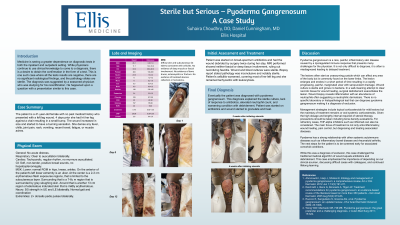Back

Clinical: General Topics
Pyoderma Gangrenosum - Sterile but Serious
Friday, March 31, 2023
12:00 PM East Coast USA Time


Suhaira Choudhry, DO
Resident
Ellis Hospital
Melville, New York, United States
Presenting Author(s)
Introduction: Medicine is seeing a greater dependence on diagnostic tests in both the inpatient and outpatient setting. While physicians continue to use clinical knowledge to come to a diagnosis, there is a desire to obtain the confirmation in the form of a test. This is one such case where all the tests results are negative, there are no significant radiological findings, and the pathology slides are sterile. The diagnosis was suggested by a seasoned physician who was studying for his recertification. He happened upon a question with a presentation similar to this case.
Case Study: The patient is a 41-year-old female with no past medical history who presented with a left leg wound. 4 days prior she had hit her leg against a chair resulting in a small bump. The wound increased in size and started to have a burning sensation. She denies any fever, chills, joint pain, rash, vomiting, recent travel, fatigue, or muscle aches. Patient was started on broad-spectrum antibiotics and had the wound debrided by surgery twice during her stay. MRI performed showed neither fascial or deep tissue involvement, ruling out necrotizing fasciitis. Wound and blood cultures were sterile. Biopsy report stated pathology was inconclusive and notably sterile. Patient’s cellulitis worsened, covering most of her left leg and she remained tachycardic with leukocytosis. Eventually the patient was diagnosed with pyoderma gangrenosum. This diagnosis explained the sterile culture, lack of response to antibiotics, elevated neutrophil count, and worsening condition with debridement. Patient was started on antibiotics and wound started to granulate and heal.
Discussion: Pyoderma gangrenosum has a strong relationship with inflammatory bowel disease as well as other autoimmune conditions. The next steps for the patient is to be screened early for associated comorbid conditions. While this was a diagnosis of exclusion, this case challenged the traditional medical algorithm of wound equals antibiotics and debridement. This case emphasized the importance of depending on our clinical acumen, discussing difficult cases with colleagues, and continued lifelong learning.
Case Study: The patient is a 41-year-old female with no past medical history who presented with a left leg wound. 4 days prior she had hit her leg against a chair resulting in a small bump. The wound increased in size and started to have a burning sensation. She denies any fever, chills, joint pain, rash, vomiting, recent travel, fatigue, or muscle aches. Patient was started on broad-spectrum antibiotics and had the wound debrided by surgery twice during her stay. MRI performed showed neither fascial or deep tissue involvement, ruling out necrotizing fasciitis. Wound and blood cultures were sterile. Biopsy report stated pathology was inconclusive and notably sterile. Patient’s cellulitis worsened, covering most of her left leg and she remained tachycardic with leukocytosis. Eventually the patient was diagnosed with pyoderma gangrenosum. This diagnosis explained the sterile culture, lack of response to antibiotics, elevated neutrophil count, and worsening condition with debridement. Patient was started on antibiotics and wound started to granulate and heal.
Discussion: Pyoderma gangrenosum has a strong relationship with inflammatory bowel disease as well as other autoimmune conditions. The next steps for the patient is to be screened early for associated comorbid conditions. While this was a diagnosis of exclusion, this case challenged the traditional medical algorithm of wound equals antibiotics and debridement. This case emphasized the importance of depending on our clinical acumen, discussing difficult cases with colleagues, and continued lifelong learning.
